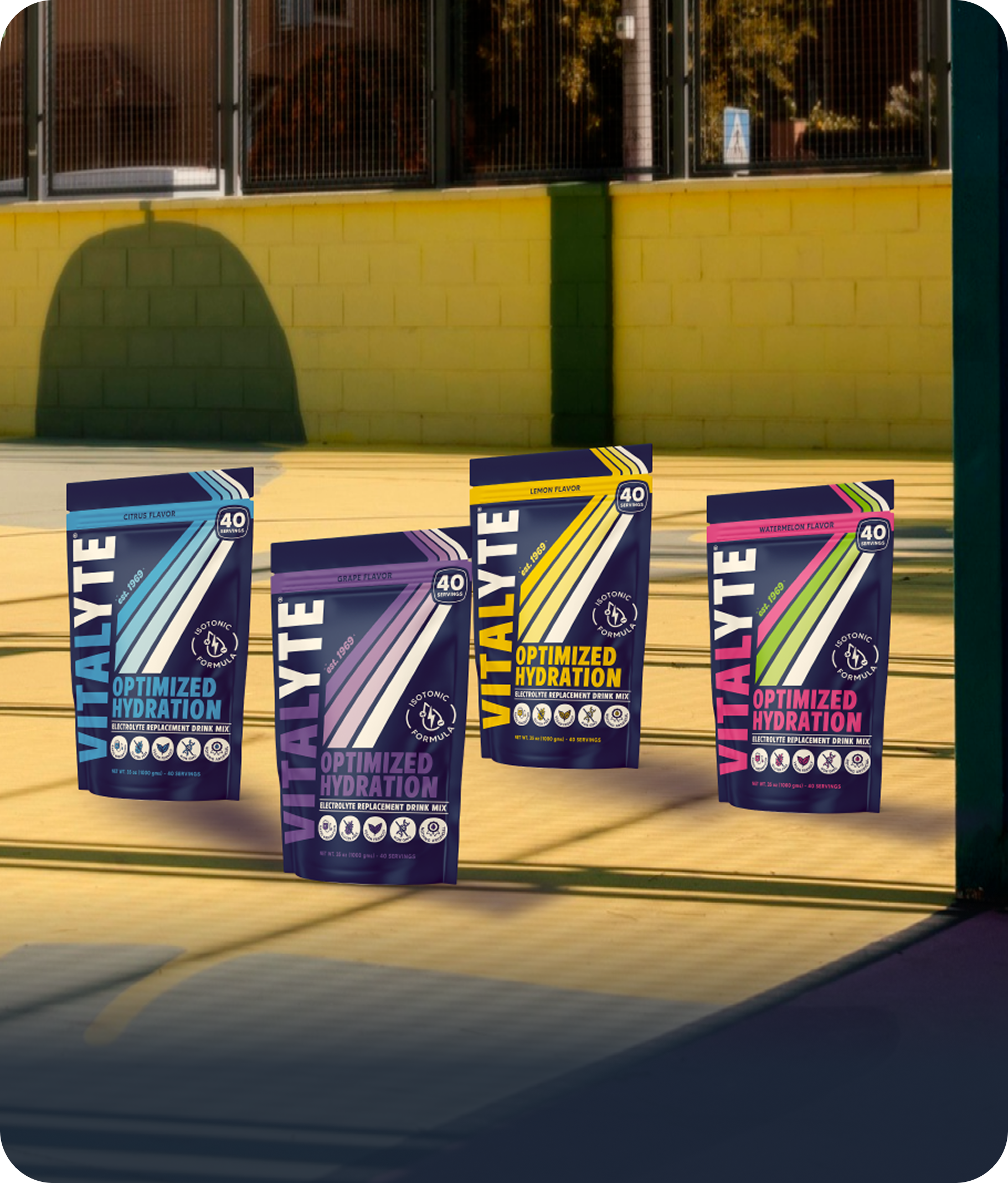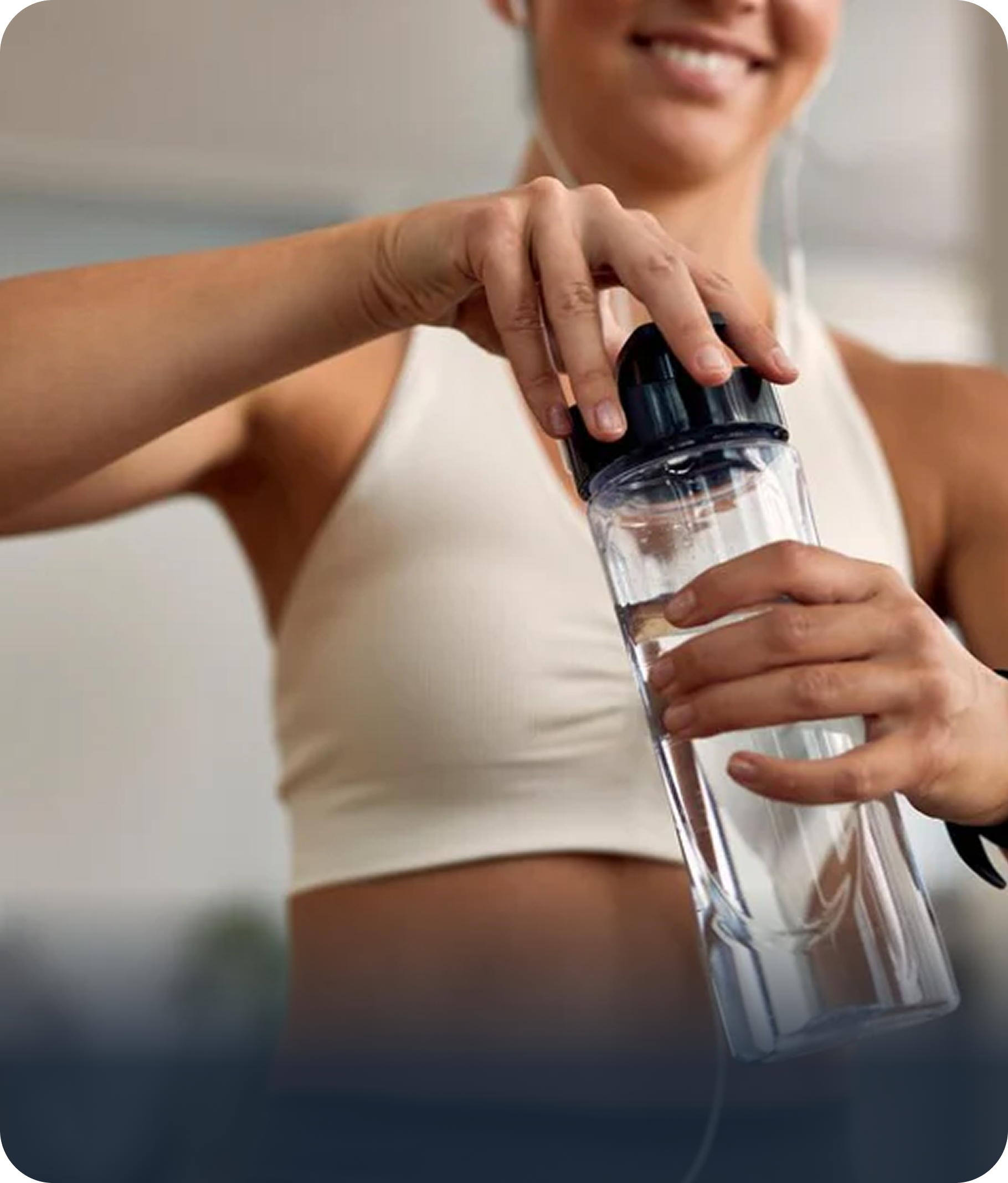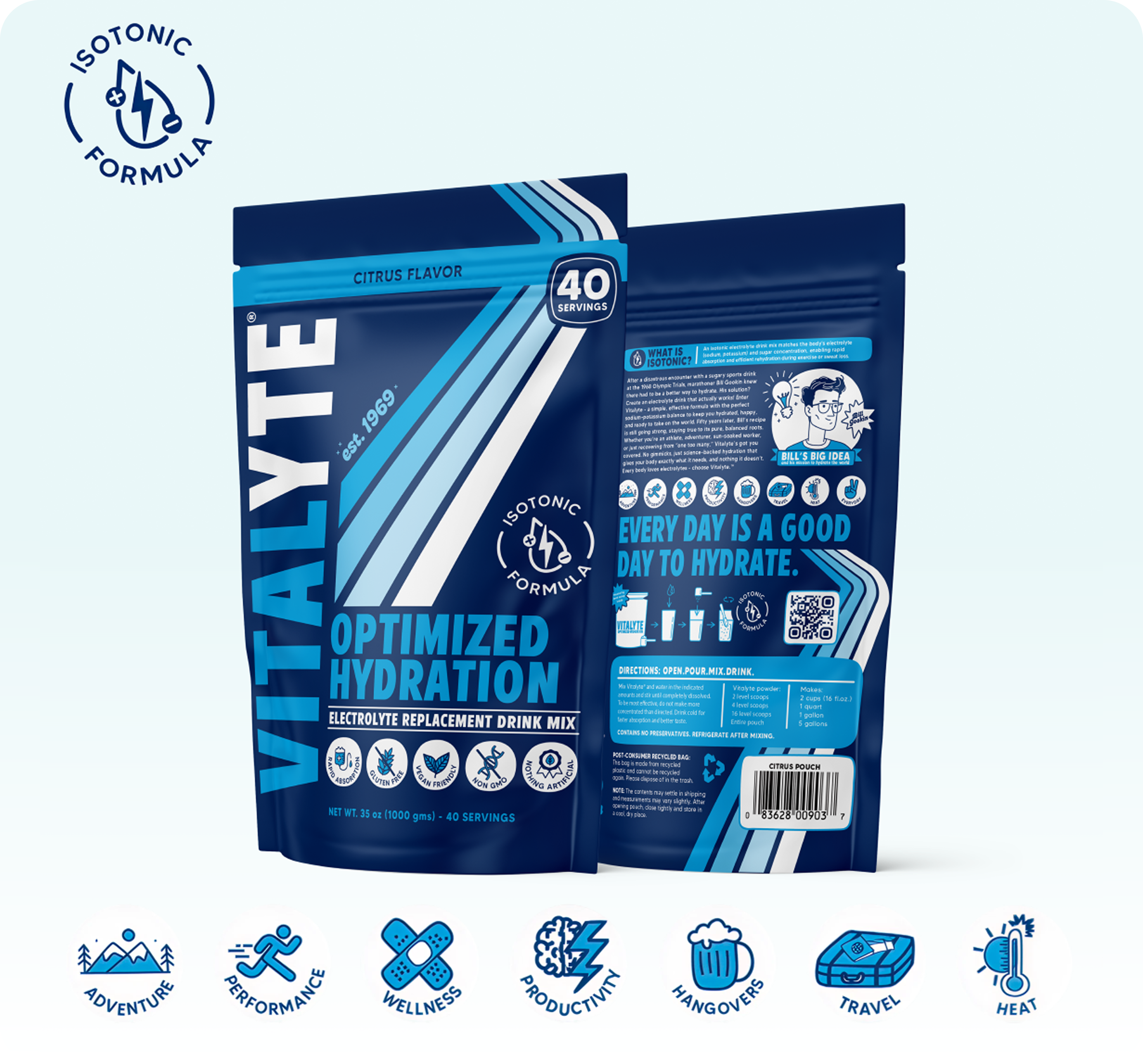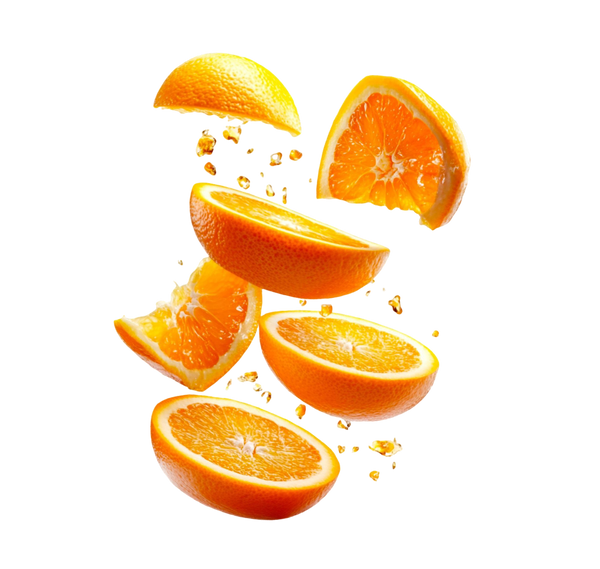Electrolyte Drink Mix: The Complete Science-Based Guide from 50 Years of Athlete Testing
Share

Electrolyte Drink Mix: The Complete Science-Based Guide from 50 Years of Athlete Testing
You've seen the Instagram ads. The celebrity endorsements. The "revolutionary" electrolyte powders promise to change your life with proprietary formulas and fancy packaging.
But here's what 50 years of real world athlete testing taught us: The science of hydration hasn't changed. What works has been known since the 1970s. The challenge is cutting through the marketing noise to find formulas that actually deliver.
This guide gives you everything you need to evaluate any electrolyte drink mix on the market, understand the science behind what actually works, and make informed choices based on your needs rather than someone's marketing budget.
We're going to be honest about things most brands won't tell you. Like when you don't need electrolyte powder at all. When the expensive brand is actually worse than the cheaper option. And why the newest "breakthrough" formula is often just repackaged science from 50 years ago.
The foundation for this guide comes from an unlikely source: a frustrated marathoner named Bill Gookin who had a disastrous experience at the 1968 Olympic Trials and spent the next 25 years obsessively testing electrolyte formulations on himself and thousands of athletes. What he discovered through relentless experimentation became the blueprint that modern sports science has validated again and again.
Let's start with what happened in 1968, because understanding that disaster explains everything about why formulation matters so much.
 The 1968 Disaster That Changed Everything
The 1968 Disaster That Changed Everything
Bill Gookin stood at the starting line of the 1968 Olympic Trials Marathon as a legitimately competitive runner. He'd trained properly, tapered correctly, and felt ready for the biggest race of his life.
Mile 18 hit him like a freight train. Stomach cramps. Nausea. Legs that suddenly felt like concrete. He'd been drinking the "revolutionary" commercial sports drink provided at aid stations, following the conventional wisdom of the era: drink the sweet stuff, stay hydrated, perform better.
Instead, he bonked spectacularly. His race fell apart. His Olympic dreams ended.
The biochemist in Bill couldn't let it go. He went back to his lab with a simple question: Why did that drink make everything worse instead of better?
What he discovered over the next 25 years of testing would become the foundation for understanding why most electrolyte drinks fail when athletes need them most. The commercial drink that destroyed his race was hypertonic (too concentrated), loaded with excessive sugar that pulled water from his bloodstream into his gut, and unbalanced in electrolytes in ways that depleted his body's own reserves.
Bill created a formula that solved all three problems: isotonic concentration matching blood osmolality, balanced sodium to potassium ratios preventing depletion, and just enough carbohydrates to enhance absorption without causing GI distress. He tested it obsessively. First on himself. Then on other marathoners. Then on ultra runners, cyclists, triathletes, and eventually thousands of athletes across five decades.
That formula, originally called Gookinaid and renamed Vitalyte in 2007, has now been used in Olympic competitions, Search and Rescue operations, medical relief missions during cholera outbreaks, construction sites in extreme heat, and by everyday athletes just trying to feel their best.
The lessons from 50 years are clear: Formulation matters more than marketing. Science beats trends. And real world testing reveals truths that laboratory studies and focus groups miss.
What Makes an Effective Electrolyte Drink Mix
Not all electrolyte powders are created equal. The difference between an effective formula and expensive flavored water comes down to four critical factors that most brands either don't understand or choose to ignore for marketing reasons.
Osmolality: The Factor Most Brands Get Wrong
Osmolality measures the concentration of dissolved particles in a solution, expressed as milliosmoles per liter (mOsm/L). Your blood sits at approximately 280 to 300 mOsm/L. This number is crucial because your body absorbs fluids fastest when the drink matches your blood's natural concentration.
Isotonic drinks (280 to 300 mOsm/L) match blood concentration and absorb rapidly without your body having to dilute or concentrate them first. Research published in Sports Medicine demonstrates that isotonic drinks (275 to 300 mOsm/L) provide optimal hydration during continuous exercise. Water moves directly from your intestines into your bloodstream.
Hypertonic drinks (above 350 mOsm/L) are more concentrated than blood. Your body must pull water from circulation into your intestines to dilute them before absorption can occur. Studies show that hypertonic formulations can actually impair fluid delivery and reduce plasma volume during exercise, creating the opposite of hydration: water displacement that causes bloating, cramping, and delayed fluid delivery.
Hypotonic drinks (below 270 mOsm/L) are less concentrated than blood. They absorb slightly faster than isotonic but deliver fewer electrolytes and carbohydrates per ounce, limiting their usefulness for sustained activity.
Bill Gookin's breakthrough came when he realized that the commercial sports drink that destroyed his 1968 race was hypertonic at roughly 380 mOsm/L. The excessive sugar concentration was pulling fluid from his muscles and blood into his gut, causing cramping and dehydration despite drinking regularly.
After 15 years of testing different concentrations, he landed on isotonic formulation around 280 to 300 mOsm/L as optimal for rapid absorption without stomach distress. Modern research has validated this finding repeatedly, yet many popular brands still formulate hypertonic drinks because they taste better on the shelf.
Sodium and Potassium: The Balance Nobody Talks About
Most electrolyte discussions focus obsessively on sodium while ignoring potassium entirely. This is a critical mistake that Bill discovered through decades of athlete feedback.
Research on sweat composition in marathoners shows that athletes lose both sodium and potassium through sweat, typically at average concentrations of 42.9 mmol/L sodium and 6.0 mmol/L potassium. However, inside your cells, potassium is far more concentrated than sodium. Cellular function, muscle contraction, and nerve signaling all depend on maintaining proper potassium levels.
Here's what happens when you consume high sodium formulas without adequate potassium: Your body must dump its own potassium reserves to maintain cellular balance. Sodium pulls water from circulation into tissues, reducing blood volume. Your kidneys work overtime to excrete the excess sodium, taking your valuable potassium with it.
The result? Dehydration despite drinking fluids. Increased cardiovascular stress. Whole body cramping that no amount of salt can fix.
Bill tested ratios extensively and found that balanced formulations closer to 1:1 or 1:1.4 (sodium to potassium) prevent this depletion cascade. Vitalyte maintains 135mg sodium to 193mg potassium per 16oz serving precisely because that ratio matches what your body needs for optimal cellular function without forcing depletion.
Compare this to high sodium trend formulas delivering 1000mg sodium with only 200mg potassium (5:1 ratio). These work for specific populations like strict keto dieters who need massive sodium replacement. But for most athletes, they create more problems than they solve.
Carbohydrate Concentration: The Goldilocks Zone
Carbohydrates serve three critical functions in electrolyte drinks: providing energy during exercise, enhancing sodium and water absorption through SGLT1 transporters in your intestines, and maintaining blood glucose during sustained efforts.
The challenge is finding the right concentration. Too little and you miss the performance benefits. Too much and you create a hypertonic solution that causes stomach problems.
Bill discovered through testing that 4 to 5% carbohydrate concentration (roughly 16 to 20 grams per 16oz serving) hits the sweet spot. This provides 30 to 60 grams per hour when athletes drink at recommended rates, matching research guidelines for optimal performance during exercise lasting 60 minutes or longer.
Most commercial sports drinks contain 6 to 8% carbohydrates or higher, making them hypertonic and slowing gastric emptying. The irony is these drinks were formulated to taste good sitting on store shelves, not to optimize absorption during exercise.
Zero sugar electrolyte powders eliminate this problem but sacrifice the performance benefits of carbohydrate fueling during longer efforts. They work well for short workouts under 60 minutes or for people prioritizing hydration over performance, but they're suboptimal for endurance athletes needing both fluid and fuel.

Natural vs Artificial Ingredients: When It Actually Matters
Bill's philosophy was simple: nothing your body doesn't need. This wasn't about following trends or marketing to the "clean label" crowd. It was about reducing variables that could cause problems during hard efforts when stomach distress can ruin performance.
The practical differences:
Artificial sweeteners like sucralose, acesulfame potassium, and aspartame create ultra-sweet zero calorie drinks. Some athletes tolerate them fine. Others experience GI distress, especially during intense exercise when your gut is already stressed. The research is mixed, but enough athletes report problems that natural options remain safer for most.
Artificial flavors and colors don't necessarily cause performance issues, but they're unnecessary. Natural fruit flavors and vegetable-based colors work just as well without adding questionable ingredients.
Glucose and fructose as carbohydrate sources absorb through different intestinal transporters, reducing GI distress compared to single sugar formulas. Bill used both in his original formula, and research has since confirmed that multiple transportable carbohydrates enhance absorption and reduce stomach problems.
The bottom line: Natural ingredients aren't automatically superior, but they eliminate potential problems. When you're 20 miles into a marathon and your stomach decides to rebel, you want the fewest variables possible contributing to the disaster.
The Science of Absorption: How Electrolyte Drinks Actually Work
Understanding how your body absorbs electrolyte drinks explains why formulation matters so much and why expensive brands often perform worse than properly designed alternatives.
The SGLT1 Transport System
Your small intestine contains specialized transporters called SGLT1 (sodium-glucose cotransporter 1) that simultaneously move sodium, glucose, and water from your intestinal lumen into your bloodstream. Research shows that SGLT1 co-transports 2 sodium ions and approximately 300 water molecules with each glucose molecule. This system is the reason electrolyte drinks work faster than plain water.
When you drink an isotonic electrolyte solution with the right sodium and carbohydrate ratio, SGLT1 transporters actively pull all three components into circulation together. Plain water relies on passive diffusion through aquaporin channels, which is slower and less efficient.
The SGLT1 system works optimally at specific concentrations: approximately 30 to 60 mmol/L glucose and 60 to 90 mmol/L sodium. This translates to roughly 5 to 11g glucose and 140 to 200mg sodium per liter. Go too high and you overwhelm the system, creating the hypertonic problems we discussed. Go too low and you don't maximize the active transport advantage.
Bill didn't know about SGLT1 transporters in 1971 when he was testing formulations. The molecular biology hadn't been discovered yet. But his empirical testing through trial and error led him to concentrations that perfectly match what research later proved optimal for this transport system.
That's the difference between formulating based on real world results versus designing drinks to taste good in focus groups.
Gastric Emptying and Osmolality
Before anything reaches your intestines for absorption, it must empty from your stomach. Gastric emptying rate determines how quickly fluids become available for absorption and ultimately reach your bloodstream.
Multiple factors affect emptying rate: volume in your stomach, exercise intensity, heat stress, and critically, the osmolality of what you're drinking. Isotonic drinks empty fastest. Hypertonic drinks empty slowest, sometimes taking 50% longer to clear your stomach.
During a marathon or long training session, this delay compounds. You drink at mile 5. The hypertonic formula sits in your stomach. You drink more at mile 8. Now you're sloshing. By mile 15 you're bloated and nauseated, with fluid trapped in your gut instead of hydrating your muscles.
Bill discovered this through painful experience. The 1968 sports drink that destroyed his race didn't just pull water into his gut. It also delayed gastric emptying so severely that fluid accumulated faster than it could be processed. He felt full, stopped drinking, and dehydrated despite consuming plenty of liquid.
Isotonic concentration solves this completely. Drinks at 280 to 300 mOsm/L empty as fast as water while delivering electrolytes and carbohydrates that water alone can't provide.
The Electrolyte Balance and Cellular Function
Every cell in your body maintains specific sodium and potassium concentrations across its membrane. Sodium is concentrated outside cells. Potassium is concentrated inside. This gradient powers nerve signals, muscle contractions, and countless metabolic processes.
When you sweat heavily and replace only fluid (or only sodium), you disrupt this balance. Excessive sodium without potassium forces your cells to export potassium to maintain the gradient. Potassium loss impairs muscle function and increases cramping risk dramatically.
The solution isn't more sodium. It's a balanced replacement matching what you're losing and what your cells need to function.
Bill tested this extensively with ultra runners who were plagued by whole body cramping despite using high sodium products. When they switched to balanced 1:1.4 sodium to potassium ratios, the cramping disappeared. Not because they were getting more total electrolytes, but because they stopped forcing their bodies to cannibalize their own potassium reserves.
Modern exercise physiology has confirmed this mechanism repeatedly. Yet the high sodium trend persists, driven more by marketing differentiation than actual science.
How to Evaluate Any Electrolyte Powder
Most people choose electrolyte powders based on packaging, price, or influencer recommendations. Here's how to actually evaluate whether a formula will work for your needs.
Calculate the Osmolality
Most brands don't list osmolality on the label, but you can estimate it from the carbohydrate and electrolyte content.
Simple estimation formula: Each gram of carbohydrate contributes roughly 6 mOsm/L. Each 100mg of sodium contributes approximately 4 mOsm/L. Each 100mg of potassium adds about 2.5 mOsm/L.
Example calculation for a 16oz (473mL) serving:
-
16g carbs = 96 mOsm/L
-
135mg sodium = 5.4 mOsm/L
-
193mg potassium = 4.8 mOsm/L
-
Total: approximately 106 mOsm/L in 473mL, which scales to roughly 280 mOsm/L when normalized
Target range: 270 to 310 mOsm/L for isotonic formulation.
If a product contains 28g carbs and 500mg sodium per serving, it's likely hypertonic and will cause problems during hard efforts.
Check the Sodium to Potassium Ratio
Divide sodium content by potassium content. Look for ratios between 0.7:1 and 2:1.
Ideal range: 1:1 to 1.4:1 Acceptable range: 0.7:1 to 2:1
Problematic: Anything above 3:1 unless you have specific needs
High sodium formulas (5:1 or higher) work for keto dieters or specific medical conditions but risk potassium depletion for most athletes.
Calculate Carbohydrate Percentage
Divide total carbs by total volume, then multiply by 100.
Example: 16g carbs in 16oz (473mL) water 16g / 473mL = 0.034 x 100 = 3.4% carbohydrate solution
Target range: 4% to 5% for isotonic with performance benefits Acceptable range: 2% to 6% Problematic: Above 7% (hypertonic, GI risk)
Zero carb formulas work for hydration-only needs but sacrifice performance benefits for efforts over 60 minutes.

Read the Ingredient List
Look for:
-
Specific sugar sources (glucose, fructose, sucrose) rather than just "carbohydrates"
-
Natural flavors rather than artificial when possible
-
Absence of unnecessary additives like artificial colors
-
Clear electrolyte sources (sodium chloride, potassium chloride, etc.)
Red flags:
-
Proprietary blends hiding actual amounts
-
Excessive ingredients unrelated to hydration
-
Claims about "breakthrough" technology that's just standard ORS science rebranded
-
Artificial sweeteners in "performance" formulas intended for hard exercise
Consider the Price Per Serving
Quality electrolyte powder should cost $0.50 to $0.80 per serving when bought in bulk containers. Individual packets cost more for convenience.
Much cheaper (under $0.40) often indicates poor formulation, missing ingredients, or low quality sourcing. Much more expensive (over $1.50) usually means you're paying for packaging, marketing, or celebrity endorsements rather than better ingredients.
Calculate the actual cost per serving based on the scoop size and servings per container. Don't be fooled by small containers making products seem affordable.
When You Actually Need Electrolyte Supplementation
Here's something most brands won't tell you: You don't always need electrolyte powder. Being honest about this builds more trust than claiming everyone needs it constantly.
When Plain Water Works Fine
For most people during most activities, plain water is sufficient:
-
Workouts under 60 minutes at moderate intensity
-
Cool weather training where sweat loss is minimal
-
Daily hydration throughout the day for non-athletes
-
Short morning runs before breakfast
-
Yoga, stretching, light activity
Your body maintains electrolyte balance through normal food intake. Unless you're sweating significantly or exercising for extended periods, additional supplementation isn't necessary and can even be counterproductive.
Bill was clear about this from the beginning: "You don't need Vitalyte for a 30 minute jog around the neighborhood. Save your money and drink water."
When Electrolyte Powder Becomes Essential
Supplementation provides real performance and safety benefits in specific situations:
-
Sustained exercise over 60 minutes: Especially at moderate to high intensity where sweat loss exceeds what you can replace through food alone. Research shows that proper electrolyte replacement during endurance exercise can improve performance by 26 minutes in middle distance triathlons.
-
Hot or humid conditions: When environmental stress increases sweat rate significantly, even during moderate activity.
-
High sweat rate individuals: Some people lose 2+ liters per hour regardless of conditions. These athletes need aggressive electrolyte replacement to prevent dehydration.
-
Multiple training sessions per day: Recovery between sessions requires rapid electrolyte and fluid replacement that food alone can't provide quickly enough.
-
Endurance events: Marathons, ultra runs, century rides, long triathlons where you're exercising for 2+ hours continuously.
-
Heat stress work environments: Construction workers, landscapers, emergency responders working in hot conditions need electrolyte supplementation to prevent heat illness.
-
Illness recovery: Vomiting, diarrhea, fever all increase fluid and electrolyte losses that need rapid replacement.
-
Specific medical conditions: POTS, chronic fatigue, certain medications that increase fluid loss all benefit from electrolyte supplementation under medical guidance.
The Gray Area: Daily Maintenance for Athletes
Many athletes in heavy training find that one serving of electrolyte drink daily, even on rest days, helps them feel better overall. This isn't marketing hype. When you're training hard 5 to 6 days per week, your body is constantly balancing elevated electrolyte turnover.
A single daily serving maintains baseline hydration status without risk of excess. It's cheap insurance for feeling and performing your best. But it's not essential if you eat a varied diet with adequate sodium and potassium from food.
Common Mistakes That Cost You Performance
After 50 years of watching athletes use electrolyte powder, these patterns emerge repeatedly:
Mistake 1: Mixing Too Concentrated
"More must be better" thinking leads athletes to use less water than directed or add extra scoops. This creates hypertonic solutions that cause exactly the problems you're trying to prevent: cramping, bloating, delayed absorption.
The fix: Follow mixing directions exactly. Bill spent 25 years testing concentrations. The recommended mixing ratio exists for scientific reasons, not arbitrary ones.
Mistake 2: Waiting Until You're Dehydrated
Reactive hydration (drinking when thirsty during long efforts) means you're already 1 to 2% dehydrated. Performance drops, mental clarity decreases, and you spend the rest of the effort playing catch-up.
The fix: Strategic pre-loading 90 minutes before long efforts, controlled intake during (6 to 8oz every 15 to 20 minutes), and aggressive recovery after.
Mistake 3: Overdrinking Plain Water During Ultra Endurance Events
Exercise-associated hyponatremia (dangerous sodium dilution) occurs when athletes drink excessive plain water during events lasting 4+ hours. This is a real medical emergency that has caused deaths.
The fix: Drink to thirst, not on a rigid schedule. Use properly formulated electrolyte drinks, not plain water, for sustained efforts. Never force fluid intake beyond comfortable levels.
Mistake 4: Choosing Based on Marketing Instead of Formulation
Influencer endorsements, celebrity partnerships, and sleek packaging don't make formulas work better. They just make products more expensive.
The fix: Evaluate osmolality, electrolyte ratios, and carbohydrate percentages. Choose based on science, not Instagram ads.
Mistake 5: Switching Products the Week Before a Race
Your GI system needs time to adapt to new formulas. Testing something "better" right before your goal event is when disasters happen.
The fix: "Nothing new on race day" applies to hydration just as much as shoes or nutrition. Test everything in training, lock in what works, stick with it.
What 50 Years of Real World Testing Taught Us
Bill Gookin spent 25 years obsessively refining his formula. The resulting product has now been used for 50+ years by millions of athletes, workers, medical teams, and everyday people. The patterns from half a century are unmistakable.
Lesson 1: Isotonic Concentration Can't Be Improved Upon
Bill tested hypotonic, isotonic, and hypertonic formulations extensively. He tried every variation he could think of. The conclusion after 25 years: you cannot improve upon isotonic concentration around 280 to 300 mOsm/L.
This isn't Bill's opinion. It's physiology. Your blood sits at 280 to 300 mOsm/L. Matching this concentration allows immediate absorption without your body having to dilute or concentrate the solution first.
Modern brands still formulate hypertonic drinks because they taste better or because they don't understand the science. The sweetness that makes something delicious sitting on a shelf is exactly what causes problems during hard exercise.
Lesson 2: Balanced Electrolytes Prevent More Problems Than High Sodium
The single most consistent feedback over 50 years: athletes switching from high sodium products to balanced 1:1.4 ratios experience dramatic reduction in cramping.
Not because they're getting more total electrolytes. Because they're no longer forcing their bodies to dump potassium reserves to compensate for sodium excess.
Bill discovered this through testing with ultra runners in the 1980s and 1990s. The pattern was unmistakable: balanced ratios eliminated whole body cramping that high sodium couldn't fix.
Lesson 3: Natural Ingredients Cause Fewer Problems
This wasn't about marketing or trends. It was purely empirical observation: athletes using formulas with artificial sweeteners and colors reported more GI distress during hard efforts than those using natural ingredients.
The difference isn't huge for everyone. Some people tolerate artificial ingredients fine. But when you're formulating for thousands of diverse athletes, eliminating unnecessary variables improves outcomes.
Bill's approach: glucose and fructose for carbohydrates, natural flavors, nothing artificial. Not because it's trendy, but because it works reliably for more people under stress.
Lesson 4: Real World Testing Reveals What Labs Miss
Laboratory studies control variables carefully. But they can't replicate the chaos of mile 22 of a marathon in 85 degree heat when your stomach is rebelling and you're questioning every life decision that led you there.
Real world testing with thousands of athletes over decades reveals patterns that controlled studies miss: which formulas cause cramping at mile 20, which ones sit heavy at mile 10, which concentrations lead to bathroom emergencies.
This is Vitalyte's unfair advantage that no competitor can replicate quickly: 50 years of feedback from millions of uses in every condition imaginable. You can't accelerate this with marketing budgets or celebrity endorsements.
Lesson 5: Simple Formulas Work Better Than Complex Ones
Bill's background was biochemistry. He could have created incredibly complex formulations with dozens of ingredients. Instead, he went the opposite direction: the simplest formula that delivers what your body actually needs.
Glucose and fructose for carbs. Sodium and potassium for primary electrolytes. Trace minerals for completeness. Natural flavoring. Nothing else.
This wasn't laziness. It was an intentional design based on decades of testing showing that adding more ingredients didn't improve performance but did increase the chance of something causing problems.
The Bottom Line: Choose Based on Science, Not Marketing
The electrolyte drink mix market is flooded with options. New brands launch constantly, each claiming revolutionary breakthroughs. Most are repackaging the same ORS science discovered in the 1960s and validated through millions of uses since then.
Here's what actually matters:
Isotonic concentration around 280 to 300 mOsm/L for rapid absorption without stomach distress.
Balanced sodium to potassium ratios between 1:1 and 1.4:1 to prevent electrolyte depletion.
Optimal carbohydrate concentration at 4% to 5% for performance benefits without GI issues.
Natural ingredients when possible to reduce variables during hard efforts.
Real world testing over time rather than marketing claims and influencer partnerships.
Bill Gookin spent 25 years testing formulations because he understood that hydration is too important to leave to chance or focus groups. What he discovered through relentless experimentation remains as effective today as it was in 1971 because good science doesn't change.
The formula Bill perfected after his 1968 disaster works for the same reason it always has: it matches how your body actually functions rather than fighting against it.
Your digestive system doesn't care about marketing claims or celebrity endorsements. It responds to osmolality, concentration gradients, and electrolyte balance. Give it what it needs in the form it can use most efficiently, and performance follows naturally.
Discover Vitalyte's isotonic electrolyte replacement drink formula or learn more about what 50 years of real world testing taught us about proper hydration.
Frequently Asked Questions
Can I make my own electrolyte drink at home?
You can, but getting the ratios and concentration right is tricky. Simple recipes with salt, sugar, and citrus work for basic hydration but often miss optimal osmolality and electrolyte balance. Pre-formulated powders that have been tested extensively are more reliable for performance applications. Save homemade versions for casual use, not important training or events.
Do I need different electrolyte formulas for different activities?
For most people, one properly formulated isotonic powder works for all activities. The difference is how much you drink and when, not the formula itself. Specialized scenarios like strict keto diets or specific medical conditions might benefit from adjusted formulations, but 90% of athletes do well with a balanced isotonic formula for everything. Learn more about electrolyte timing strategies for different activities.
How do electrolyte drinks compare to energy gels plus water?
Energy gels are ultra-concentrated and require 6 to 12oz of water per gel to prevent GI distress. Isotonic drinks deliver both hydration and carbohydrates in one optimal package. For shorter races where you need maximum carbs in minimum time, gels work well. For longer efforts where GI tolerance matters, isotonic drinks reduce complications while delivering both fluid and fuel efficiently.
Are electrolyte tablets as effective as powder?
Tablets are convenient but often lower in electrolyte content per serving and may include binding agents and fillers. They work fine for moderate needs but are less optimal for high sweat rate athletes or long endurance efforts. Powder allows more precise mixing and typically delivers better value per serving. Choose based on your priority: convenience (tablets) or optimal formulation (powder).
Can too much electrolyte powder be harmful?
Using multiple servings daily as directed is safe for most people. Problems occur when people drastically exceed recommendations or have underlying kidney or heart conditions. The bigger risk is using ultra-high sodium formulas that force potassium depletion. Stick with balanced formulations and follow serving suggestions. If you have medical conditions affecting electrolyte balance, consult your physician before using sports drinks regularly.
Do electrolyte drinks help with hangovers?
Yes, because alcohol causes dehydration and electrolyte loss. A properly balanced isotonic formula helps rehydrate faster than water alone. However, hangover symptoms include factors beyond just dehydration (inflammation, sleep disruption, acetaldehyde toxicity) that electrolytes can't fix. They help but aren't a complete solution. Better yet, drink the electrolyte solution before bed after drinking alcohol to prevent severe dehydration overnight.
How long can I store mixed electrolyte drinks?
Mixed drinks should be consumed within 24 hours if refrigerated. Natural formulas without preservatives are prone to bacterial growth at room temperature. Make only what you'll drink that day. Dry powder in sealed containers lasts 12 to 24 months. Once opened, use within 6 months for best flavor and effectiveness. Store in a cool, dry place away from moisture.
Why do some electrolyte drinks taste salty while others are sweet?
Taste reflects formulation priorities. High sodium formulas (1000mg+) taste very salty. Isotonic balanced formulas taste mildly sweet with slight mineral notes. Products loaded with artificial sweeteners taste candy-sweet but deliver little substance. Bill designed Vitalyte to taste clean and slightly sweet, refreshing during hard efforts without the cloying sweetness that becomes nauseating during long workouts. Palatability during exercise at mile 15 matters more than taste sitting on a shelf.
Medical Disclaimer: This article provides general information about hydration and electrolyte supplementation. It is not medical advice and should not replace consultation with healthcare professionals. If you have kidney disease, heart conditions, high blood pressure, or take medications affecting fluid or electrolyte balance, consult your physician before using electrolyte supplements. Individual hydration needs vary based on sweat rate, exercise intensity, environmental conditions, and personal health status.
About the Author
Evan Lucas, COO of Vitalyte
Evan has been with Vitalyte for 27 years, working to carry forward Bill Gookin's legacy of creating honest, effective hydration solutions. He uses Vitalyte daily for general wellness and hydration, and helps guide the company's commitment to real-world testing and straightforward science over marketing hype.

























